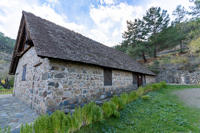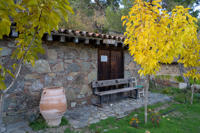Church of the Holy Cross of Agiasmati
The Church of the Holy Cross of Agiasmati is one of the ten painted Byzantine churches in the Troodos mountain range that has been granted World Cultural Heritage status by UNESCO. This church, also known as Timios Stavros tou Agiasmati, is located in the eastern part of the mountain range in the area of Pitsilia, approximately five kilometers northeast of the village of Platanistasa. The church used to be the katholicon of a monastery with the same name, which was built towards the end of the 15th century.
The name 'Agiasmati' is believed to derive from the word 'Agiasma' (-atos), which means sanctified water, spring, or well near a church. Another interpretation is that the name is related to Agiasmati in western Asia Minor, a place related to the capture of Constantinople in 1453. It is possible that refugees from this area took shelter in Cyprus and later founded a monastery with the same name in the mountains of Cyprus, in commemoration of their homeland.
The church is a single-aisled building with a steep-pitched timber roof covered with flat tiles. Its roof extends beyond the main structure to form a portico on all four sides, a unique feature in Cyprus. The building was erected with the donation of a priest named Petros Peratis and his wife Pepani, as inscribed on the exterior north wall above the entrance. Both of them are depicted on a wall-painting on the south exterior wall, offering a model of the church to Jesus with the mediation of the Virgin. The year of the church's erection is not known, but it is generally accepted that its decoration was completed in 1494, indicating a date for the construction of the church.
The interior of the church is completely painted, including the tie beams that support the wooden roof. The wall paintings are a mixture of Palaiologan and local naive art, blended with Italian Renaissance influences, and are of particular interest. The painter was Philippos Goul, a hellenised Syrian Orthodox with good education. The paintings unfold in two tiers, with multi-person scenes from the New Testament depicted in the upper tier, and individual figures in the lower tier. The narrative cycle of the Discovery of the Holy Cross, to which the church is dedicated, is located in miniature paintings on the north blind arch. On the bema's apse, the Virgin in the type of Vlachernitissa is depicted.
The church's external face of the west and south walls also has surviving wall-paintings. The extensive and multi-person Last Judgment scene, which unfolds up to the far end of the gable where Jesus Christ is depicted, is worth mentioning. The general impression of the paintings is pleasant and sometimes quite impressive, even though Goul's mastery of each style is different.
As far as the rest of the monastic buildings are concerned, only traces of the cells survive to the south of the church. When Vassili Barsky, a Russian monk, visited the island in 1735, the monastery was almost abandoned and inhabited by only one monk, who was also the abbot, and a servant. Today, the Church of the Holy Cross of Agiasmati is an important cultural and religious site that visitors can explore to appreciate its historical and artistic significance.
In conclusion, the Church of the Holy Cross of Agiasmati is an important cultural and historical monument located in the Troodos range of Cyprus. The church is a beautiful example of Byzantine and post-Byzantine monumental art, and its wall paintings are of particular interest since they represent a mixture of Palaiologan and local naive art, blended with Italian Renaissance influences. The church is also unique in its architecture, with a steep-pitched timber roof covered with flat tiles that extends beyond the main structure to form a portico on all four sides. It is a popular destination for tourists interested in Byzantine art and architecture, and its inclusion in the UNESCO World Heritage List highlights its significance and value to the cultural heritage of Cyprus.
General Information
Ratings
Spectacular
1
Fantastic
0
Enjoyable
0
Average
0
Terrible
0
5.0



